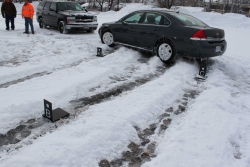Forensics - Photogrammetry
Photogrammetry is the science of extracting measurements from photographs. It has uses in all areas of forensics and many other industries. In the field of forensics, DCM Technical Services has applied photogrammetry to solve vehicular crush, map collision scenes, determine dimensions of a suspect from surveillance camera footage and even map visibility snow banks that had long since melted!
There are two types of Photogrammetry classifications. DCM uses the first classification called Close-range Photogrammetry. Close-range Photogrammetry uses non-specific, everyday cameras to create drawings and 3D models of items, locations or buildings.
The other classification is Aerial Photogrammetry which typically focuses on topographic products such as terrain or topographic maps. DCM is capable of processing aerial photographs as well. If you do not already have images for this purpose we can arrange proper flight parameters to ensure proper coverage and accurate results.
DCM is capable of determining measurements using Photogrammetry via two processes. The first includes processing from pictures to provide scientific conclusions of measurements of the item in question. These pictures can be historic in nature and age or of recent development.
The second process involves DCM attending a scene or location to take pictures as a component of the service for analysis.
The benefits of using Photogrammetry for Forensic analysis include:
- The calculation of measurements can be completed for many different types of investigations.
- Measurements taken from pictures result in non-intrusive activity of crime and accident scenes.
- DCM can use photos from multiple parties, including bystanders, media, etc... All photos can be processed to provide some level of information to support the investigation.
- Photogrammetry allows investigators the opportunity to review evidence at a later date should it be necessary, through the photographs (after the scene has long since been cleared). Investigators could return to the evidence years after an incident with photographs.
 |
 |
